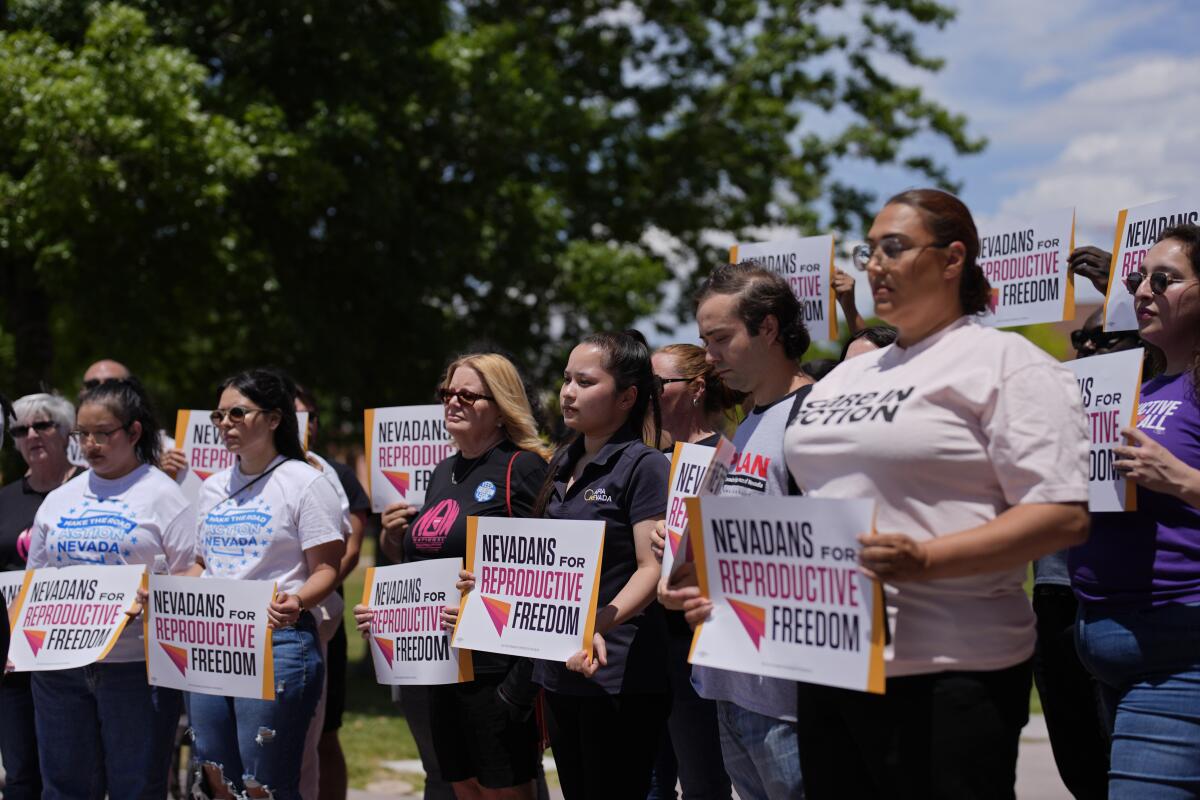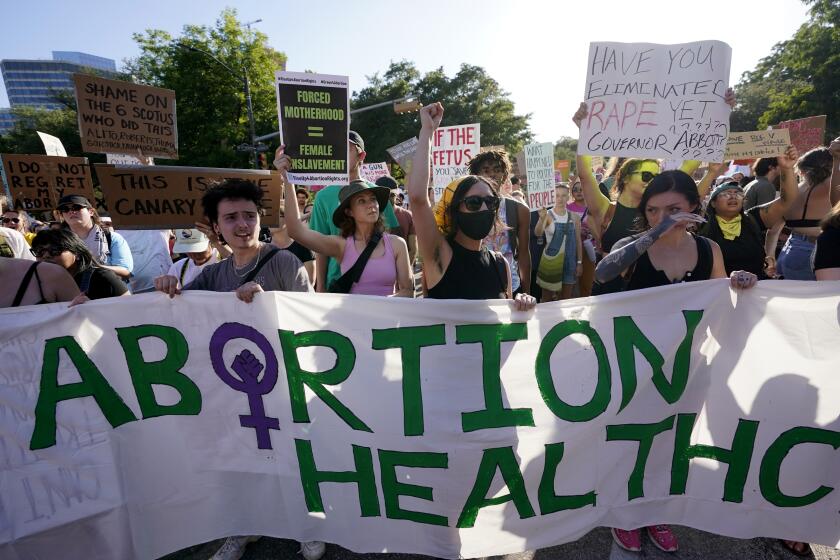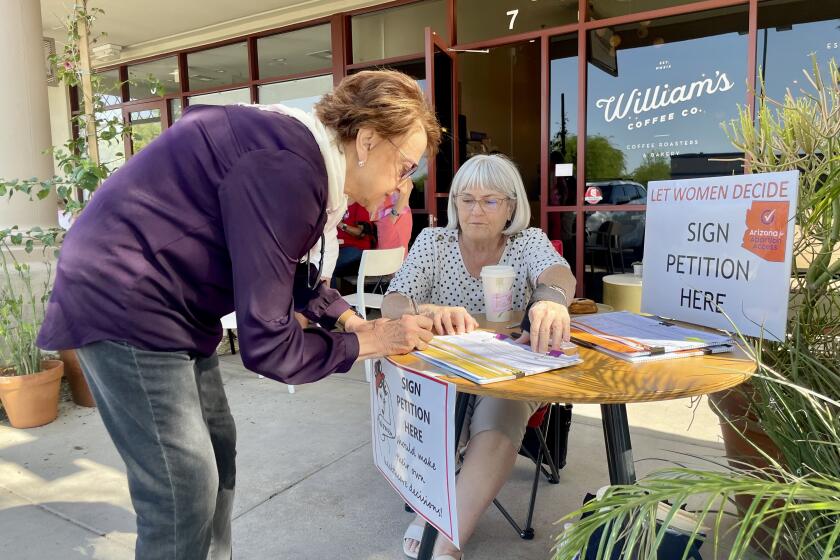Years after California put abortion on the ballot, Nevada and others try the same. It won’t be so easy.

- Share via
LAS VEGAS — Nevada organizers last month celebrated a flood of voter signatures in support of placing a measure ensuring abortion rights on the November ballot.
But their work isn’t over — not even close.
Nevada is among about a dozen states where abortion activists are working to put the protection of reproductive rights into voters’ hands, as California did two years ago. But unlike in liberal California, organizers in some of those states must navigate a patchwork of onerous bureaucratic hurdles and overcome hostile political opposition.
Ballot measures in neighboring Nevada seeking to amend the state constitution must be approved by voters in two consecutive general elections.
“We will have to go through the process all over again,” Tova Yampolsky, the campaign manager for Nevadans for Reproductive Freedom, said from a coffee shop in May just minutes from the casinos along the Strip as signatures were being officially tallied by election officials across the state.
For organizers like Yampolsky, that means at least two more years of uncertainty in an already uncertain political landscape after the U.S. Supreme Court overturned the right to abortion nationwide in 2022. While former President Trump, the presumptive 2024 GOP nominee, has so far stopped short of calling for a national abortion ban, he has supported limiting access and has taken credit for appointing the conservative justices who overturned Roe vs. Wade.
Yampolksy’s team will have to fight for attention in the perpetual swing state, but in some ways, getting voter approval is the easy part. Recent polling shows strong abortion support among Nevadans.
A decision by the Arizona Supreme Court that aims to impose a near-total abortion ban in the state has put Southern California providers on alert.
It’s the path to the ballot that’s proving difficult. The campaign has already fended off Republican backed legal challenges over the ballot measure language. Now, they wait to see if they gathered enough eligible signatures equal to 10% of the total votes cast in the most recent general election — more than California’s 8% threshold. While California has no geographical requirement for signatures, in Nevada, support must be gathered equally from each of the state’s four congressional districts.
“We’re going to have to fight for every vote,” Yampolsky said. “We’re not taking anything for granted.”
Within weeks of the Supreme Court decision overturning federal abortion protections, the California Legislature was among the first in the nation to approve a statewide ballot measure to guarantee the “fundamental right to choose to have an abortion.” Top Democrats including Gov. Gavin Newsom helped pump millions of dollars into the campaign, and nearly 67% of voters approved the measure in the November 2022 election.
Voters in a handful of states, including Ohio, Michigan and Vermont, approved similar protections. More initiative efforts are now underway in states such as Arizona, Montana, Colorado, Arkansas and Florida.
“We’re seeing the important role that direct democracy plays in making sure the will of the people is heard,” said Chris Melody Fields Figueredo, executive director of the Ballot Initiative Strategy Center, which supports progressive causes. “Ballot measures are a key part of a thriving democracy. It’s giving people the agency to vote on issues that are incredibly popular and often transcend party lines.”
Some states have a more difficult path to abortion rights by way of direct democracy than others — and legislative attempts to make the ballot initiative process even harder have proliferated in recent years.
“Every legislative session we’re seeing new efforts to undermine the will of the people,” Fields Figueredo said.
California ballot measures require a simple majority of votes to win. In Florida, where abortion is banned after six weeks of pregnancy, initiatives require a 60% supermajority of votes to pass, and state Republicans recently tried to increase that threshold even higher to a two-thirds vote, or about 66%.
Abortion is banned in Arizona after 15 weeks of pregnancy, and reproductive health advocates remain leery about future access after a state court recently attempted a near total ban. Organizers say they have already acquired more than enough signatures to qualify for a ballot measure to secure abortion access in November.
As Biden battles for reelection, he’s counting on reluctant voters to come around and measures such as Arizona’s abortion rights initiative to prod them his way.
To get on the ballot in Arizona, initiatives must get signatures that equal at least 15% of the electorate, and the Legislature has proposed adding a new requirement for that threshold to be met in each congressional district, not just statewide. Arizona Republicans also attempted to pass a law that would have allowed the Legislature to rein in some decisions made by ballot initiatives, but ironically, that proposal had to go to voters — and was rejected in 2022.
Republican lawmakers in Arkansas and Missouri, where ballot measures for abortion rights are underway, have also tried to make it harder for residents to legislate at the polls.
The timing is no coincidence, said Mini Timmaraju, president and chief executive of Reproductive Freedom For All, formerly NARAL Pro-Choice America.
“They don’t have the majority and haven’t had the majority in a long time on this issue,” Timmaraju said of anti-abortion lawmakers nationwide. “They’ve orchestrated a whole mechanism to subvert and go around the majority will in this country.”
Anti-abortion activists have been working to thwart the initiatives, with some backing competing ballot measures — a move that abortion-rights groups say is meant to deter and confuse voters.
Nevada Right to Life Director Melissa Clement opposes the proposal in her state and accused Democrats of “taking one of the most difficult and traumatic decisions a woman can make and using it for political fodder.”
While organizers see newly proposed rules as strategic hurdles that make citizen led initiatives harder to succeed, Republicans who support them say that changing state constitutions is a serious matter that requires more safeguards.
Some states do not allow citizen led initiatives at all, including Texas and West Virginia, where most abortions are banned.
As in California, abortion is legal in Nevada up to 24 weeks, and providers have reported that they have seen an influx in patients from other states. Nevada voters in 1990 passed a referendum protecting abortion rights after the Supreme Court ruled in favor of more abortion restrictions then.
Lindsey Harmon, executive director of Planned Parenthood Votes Nevada, said even before the Dobbs decision, Nevadans prioritized “individual freedoms.” While abortion is legal in her state, she fears that the future is dependent on who is in office.
“There’s still threats out there,” Harmon said. “Even when you pass a measure successfully, you then have to go back and enforce that. You have to make the Legislature pull back old laws that are no longer constitutionally viable. You have to ask the regulatory bodies to go in there and change the regulations to match what is now in the state constitution. So this is a never-ending battle.”
The Associated Press contributed to this report.
More to Read
Sign up for Essential California
The most important California stories and recommendations in your inbox every morning.
You may occasionally receive promotional content from the Los Angeles Times.













